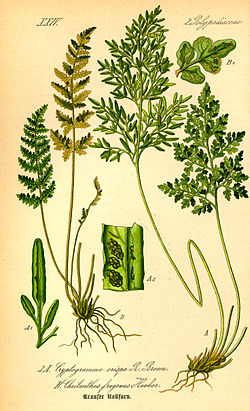| Cryptogramma | |
|---|---|
 | |
| Cryptogramma crispa | |
| Scientific classification | |
| Kingdom: | Plantae |
| Clade: | Tracheophytes |
| Division: | Polypodiophyta |
| Class: | Polypodiopsida |
| Order: | Polypodiales |
| Family: | Pteridaceae |
| Subfamily: | Cryptogrammoideae |
| Genus: | Cryptogramma R.Br. |
| Type species | |
| Cryptogramma acrostichoides | |
| Species | |
| Synonyms | |
| |
Cryptogramma is a genus of ferns known commonly as rockbrakes or parsley ferns. They are one of the three genera in the Cryptogrammoideae subfamily of the Pteridaceae. [1] Cryptogramma ferns can be found in temperate regions on several continents worldwide. These ferns have two kinds of leaves which often look so different that at first glance they appear to belong to different plants. The fertile leaves have long, narrow, bumpy segments with undersides covered thickly in sporangia. The edges of the segments may curl back to cover the sporangia, forming a false indusium. The sterile leaves have thinner, wider segments which may be rounded and resemble the leaves of parsley. These ferns grow in rocky areas, often in crevices and cracks.